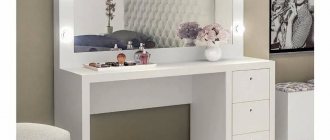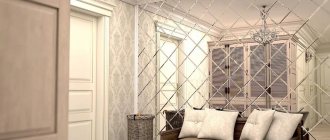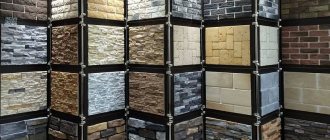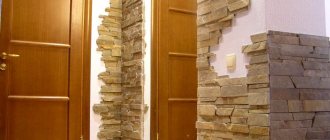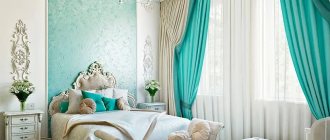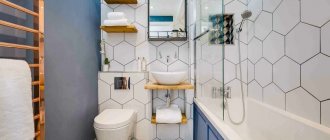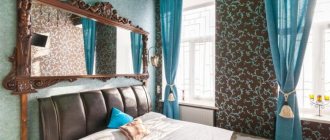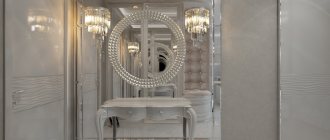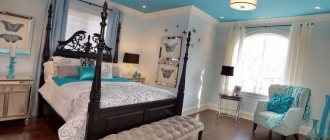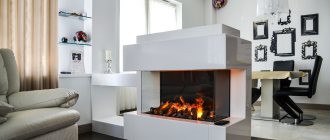Natural marble in the interior creates a special style of grace and noble luxury in the room. A unique pattern, pleasant texture, shimmering shine, and many color shades allow this type of natural stone to organically fit into any interior design and create real design masterpieces. We invite you to take a short excursion into the history of a unique natural stone - marble, and get acquainted with popular solutions for using this material in modern design.
Marble floor in the interior Source mydecorative.com
Peculiarities
Decorators try to highlight gray, white and colored marble in the interior. And the main difference is not only in the color itself, but also in the area of use, in processing methods. White marble is characterized by significant fragility and is unsuitable for outdoor work; there it is used in exceptional cases.
In addition to mechanical disturbances, negative effects due to weather conditions may be detected. This manifests itself in yellowness and the formation of spots.
The gray type of marble is mechanically stronger and relatively easier to process. This material hardly suffers from the weather, so it can confidently be used to decorate both the inside of the room and the façade.
In terms of practical qualities, colored marble is approximately equivalent to gray marble, but is much more aesthetically pleasing, which is why it is more valuable. Such a mineral has a lot of colors, and sometimes it’s not even a specific color that is selected, but the veins of a characteristic type that intersect the stone in different places. Colored marble, like gray, is equally applicable in exterior and interior decoration.
It is worth considering that in any case it is still a “delicate” stone. Products and coatings made from it may not cope even with normal operating conditions. Marble window sills, countertops and even stairs look good, of course. However, they are inferior in wear resistance to their granite counterparts.
Therefore, in most cases, critical areas are covered with granite, and marble is used inside buildings.
According to experienced designers, marble needs to be combined with warm materials. This material is good in moderate versions and designs, especially when it comes to private homes. If there is an excessive saturation of marble products and surfaces, the room looks too cold and no longer seems like a comfortable home.
The polished type of material is sensitive to lighting: if it is selected ineptly, instead of revealing its advantages, flaws are emphasized.
White and gray stone looks quite good in modern interiors, and slabs are ideal for bathrooms.
Types of marble stone
Interior solutions for mountain marble are based on the use of decorative characteristics of the material: color shade, surface texture and, of course, strength.
For marble, the color characteristics and pattern of the stone come to the fore. Depending on the color palette, the following types of marble are distinguished: white, gray, black, green, blue and even silver-lunar.
This difference in color shades is obtained due to the admixtures of minerals that make up the marble rocks. As an example, we propose to consider the most characteristic color characteristics of the stone.
Marble with veins Source yandex.net
White
Ideal for creating various sculptures, figurines, candlesticks and other decorative items. White marble contains virtually no admixtures of other minerals, and is considered the standard of marble rock.
In nature, there are stones with small veins of various colors, which, when sawed, give a natural, unique pattern. White marble in the interior of the living room gives a special asceticism, characteristic of design in the minimalist style.
White marble Source www.mirlandshaft.ru
Grey
Polished marble with a rich color palette in gray tones and various inclusions is the most favorite type of finishing material among designers.
An inexpressive gray background allows you to advantageously highlight the beauty of the vein patterns and texture of the stone.
A marble bathroom made of polished gray marble emphasizes the dazzling beauty of snow-white sanitary ware and the shine of chrome taps, towel holders, and coat hooks.
Gray marble Source keramkrasnodar.ru
To dilute the monotony of the interior, accessories in red shades are added. This could be an insert made of ceramic tiles, towels, or a floor mat.
Black
The dark shade gives the stone a high content of graphite or natural bitumen. The most valuable is black marble stone with golden veins and interspersed with gold.
Black marble in the interior is the height of sophistication and sophistication. And if iron sulfate predominates in the composition of marble rock, then the stone acquires a bluish tint.
Black marble Source pinimg.com
Blue
This type of marble is considered the rarest type of mineral. The impurities of blue dioxide give the stone an unusual hue. Color intensity: from blue to dark purple, directly depends on the concentration of this impurity.
Due to its amazing colors, blue marble is used in the interior as the dominant one, or with its help, accent color spots are created, emphasizing the unique unusualness of the composition.
Blue marble Source dvkeramik.ru
Other shades
In green marble, the color is given by impurities of iron-containing silicates, and in red marble - by iron oxides.
Green marble Source yandex.net Red marble Source mircamnya.ru Red marble Source yandex.net
Brown marble Source shtab-kvartira.com
Regardless of the color shade, marble, like all natural stones, has a unique energy and natural uniqueness. Interior compositions using this noble material always have a stylish, sophisticated look and give the room respectability and uniqueness.
Due to its unique pattern, pleasant texture, variety of color shades and halftones, marble stone organically complements the modern interior, emphasizing the exclusivity of the room design.
Marble adds exclusivity to the interior Source www.optomtile.ru
Marble elements
Marble window sills have become widespread. They are made from natural stone mainly by water cutting. Such products will become a real highlight in any room and will delight the owners with their strength and durability.
The walls are usually decorated with slabs of various shapes and sizes. The crumb is used to form decorative plaster.
There may also be:
- reliefs;
- mantel;
- columns;
- countertops;
- flights of stairs;
- floors;
- flowerpots;
- balusters.
Marble floor layout options
And although white predominates here, black brings dynamism to the interior
One canvas
In this case, slabs, slabs measuring 3x2 m are used. With their help, seamless floors are obtained that look like a solid canvas. To make the finish more expressive, you can choose a type of marble with a clear vein pattern.
It's worth thinking about . Large marble tiles measuring 1x3 m or 1x1 m also allow you to do without seams, which means making the floor more practical and easier to clean. This is possible thanks to special processing of the ends, which subsequently fit tightly together and do not form cracks.
Tile
An example of a checkerboard layout in floor finishing
Black lines emphasize the geometric nature of the diagonal layout.
Square or rectangular marble tiles are attractive with a variety of layout options. Elements of the same shape and size can be laid:
- parallel to the walls;
- diagonally;
- in a checkerboard pattern;
- with and without displacement;
- stripes, combining different types of marble.
If you take large and small tiles, you can play with the arrangement of elements and get all kinds of patterns. At the same time, smaller elements can become an accent that brings dynamics to a monochromatic canvas. This effect will be enhanced by color contrast: in this case, you should choose large white tiles and black or blue small ones.
Mosaic, ornaments
Gray marble takes on a luster when surrounded by white.
Inspired by natural motifs, geometric, floral, ethnic and other patterns, designers make them the basis for creating marble floors. Elements of a pre-designed design are cut from stone slabs, then laid in place, sanded and polished to give a glossy shine.
The result is an original pattern that combines the purity of lines, the nobility of marble and its unique texture
This is interesting . Creating a pattern often involves the use of metal elements that harmoniously combine with natural stone.
Panel
This is a complex but effective decorative element that refers to the interiors of palaces. You can see an example of laying marble panels in the photo below. The main features of this decoration:
- it requires a calm background of white, beige or light gray stone around it;
- the motif is single, but consisting of hundreds of different sized parts;
- Suitable for decorating the floor of a room in a classic or neoclassical style.
Marble panels are laid out according to the mosaic principle. But thanks to the multi-format elements, it gives the impression of a floor painting, and not just a drawing made of pieces of stone.
The larger the panel, the more space it requires around itself
Completed projects with marble panels:
- Classic house. Panel with plant motifs.
- Count's forest. Marble floor and murals in the hall.
- Luxurious marble panel in the hall on the 1st floor
What does it go with?
The combination of marble and wood is a time-tested solution. This approach ensures harmony and a beautiful visual appearance of the composition. Wood should be the “first violin”; stone only emphasizes its advantages. In turn, thanks to wooden surfaces, the marble parts of the composition lose their excessive heaviness and become warmer and more comfortable.
The combination of marble and concrete only seems unnatural, but in fact they look very good together. Of course, if everything is carefully selected. One of the materials creates a feeling of luxury, while the second supports visual associations with the metropolis.
The selection of a combination in a particular case should be carried out by specialists, and very carefully. Most often, polished surfaces are used next to concrete.
It is logical that many people want to combine marble with brick. But, as in the previous case, the help of professional designers is needed here. Often the brick look is given a dominant role. Marble details, accordingly, occupy secondary places. And, of course, you must also take into account your own taste, intentions and material capabilities.
Advantages
In the recent Soviet past, finishing with natural stone was very popular and was used in the creation of architectural objects. Currently, the material has become much more expensive, so it is used mainly in premium interiors.
The material is in wide demand due to several undeniable advantages:
- durability - one of the strongest materials that can serve for decades, or even centuries, withstanding enormous loads;
- ease of use - the coating does not crack when sawing, which makes it easy to give it the required shape;
- the ability to lay as a continuous sheet without seams;
- waterproofness - thanks to this property, you can safely lay marble tiles in the kitchen and bathroom;
- sound insulation - able to absorb noise and dampen various types of vibrations.
Natural marble has only two significant drawbacks - its high price and low temperature. It is very cold, so when laying floors with it, it is better to equip a heating system.
What types are there?
Marble in the interior can be real or simulated. Let's consider the features of each type, the pros and cons of use.
Natural marble
Natural marble is produced in the format of plates, slabs, slabs of various sizes, as well as marble chips. By mixing it with polyester resin you can get a strong tabletop for any purpose. Flexible stone deserves special attention: a modern finishing material that is a thin slice of stone glued to a flexible base.
Another production option is in the form of ready-to-use products: marble countertops, wall and floor tiles, mosaics, sinks. The advantages of natural materials include:
- strength and durability (service life more than 100 years);
- hygiene (bacteria, fungi, mold do not live on the surface);
- resistance to high temperatures;
- beautiful appearance.
Among the disadvantages, in addition to the high cost, is the complexity of processing. It is almost impossible to make a product from this stone yourself.
Imitation marble
Imitation stone is available in completely different formats and materials. General advantages of “counterfeits”:
- Various colors. In addition to natural natural tones, it can be quite unusual: pink, burgundy, blue.
- Ease of processing. PVC is cut with a regular knife, tiles are cut with a special one - but even this can be laid on the walls or floor with your own hands.
- Profitable price. Any material that imitates texture is cheaper than the original. Therefore, the decision to add marble to the interior will not be expensive.
Characteristics and benefits of marble finishing
Marble is a stone, natural, environmentally friendly, and therefore expensive material.
It has a smooth, attractive glossy surface, with a pattern of veins and shades of different shades. There are marbles in the following colors: white, gray, green, yellow, pink, red-brown, black, blue and all kinds of shades. Marble, glass and bronze: a classic combination for sophisticated design.
A room decorated with white and gray stone looks very elegant; all details should be thought through to the smallest detail, because light colors cannot be falsified. Blue and black marble do not get dirty easily; it is most often used to decorate the floors or walls of public spaces.
Material characteristics:
- heavy and durable. Withstands large mechanical loads, resistant to damage;
- wear-resistant and durable. The stone does not change shape, does not lose color or shine, does not scratch, and is ideal for flooring;
- resistance to ultraviolet radiation;
- refractory;
- does not deform or crack at high negative and positive temperatures;
- moisture resistant;
- completely harmless to the body;
- practical and modern at all times.
These are the characteristics of natural stone. Such finishing will be expensive, considering the price of the material itself and the services of the master, since it is very difficult to lay marble on the walls or floor yourself. But the marble interior looks good and will last for decades.
At all times, marble was considered the most expensive and durable way to decorate a room.
Using marble in the interior has the following advantages:
- Aesthetic aspect. Marble has a wide range of colors and textures, which allows you to choose the best option that matches other items in the room.
- Versatility. Using modern technologies, cladding sheets of any size and thickness are produced. Countertops, sinks, bathtubs, columns, benches, statues and other decorations are also made of marble.
- Environmental friendliness. Natural stone does not cause harm to health, does not cause allergies and does not pollute the atmosphere.
- Duration. The material does not deteriorate over time, does not shrink and does not lose its luster of color.
If we talk about other options for cladding with artificial marble, then there will be other features and other advantages.
Ceramic tiles and porcelain tiles
Decorating rooms with marble-effect tiles is a classic solution that will fit into any interior and fit into any budget. In construction stores there are many options for decorative coatings: from economy to luxury class.
Compared to natural white marble, tiles are less durable - but their wear resistance is often more than enough for decorating residential premises. Another drawback is the seams between the elements of porcelain stoneware or tiles. But if the work is done well, they should not be noticeable.
Decorative plaster
It is surprising that this wall material is rarely used: glossy Venetian plaster is seamless, durable, and has an unsurpassed visual resemblance to natural marble.
But you need to trust the imitation of marble in the interior with the help of plaster to a professional: only a worker with extensive experience will be able to create a unique accent wall.
Wallpaper
The easiest way to fit stone into the interior of the living room is with wallpaper: high-quality gluing joint to joint will create a seamless surface in the right place. Wallpaper can be standard: non-woven or vinyl, or self-adhesive. The latter are not afraid of water and are easy to clean.
PVC panels
Budget plastic panels are weakly associated with the concept of “luxury” inherent in marble. But if the task is to decorate a bathroom on a budget, they are perfect! You can find various shades on sale: pink, blue, beige gray. And also textures: imitation of tiles, sheet stone, etc.
Laminate
This material mainly imitates wood, but in the collections of manufacturers you can also find expensive stone textures. For example, a selection of Impressive Patterns from Quick Step featuring marble tiles.
Linoleum
Rolled marble flooring is even less common than laminate flooring. Dark color options are available in stores, mostly commercial grades - because... Marble is very popular in office and retail spaces.
MDF panels
Wall panels are a ready-made option for finishing a kitchen apron and other vertical surfaces. Most manufacturers produce the same motifs on panels and countertops, so when ordering a kitchen you will not have problems with one surface not matching another.
Decorating with marble is a stylish solution for modern interiors
The splendor of marble was first appreciated by the Greeks. They were attracted not only by the plasticity of processing, but also by the absolute smoothness and shine of the finished product. Marble is a unique stone.
Luxurious interior decoration of a marble kitchen.
It is able to shine even in the twilight, possessing an almost hypnotic brilliance. Architects and designers liked this property, so marble began to be used everywhere for interior decoration.
Marble in the interior of the living room.
There are several varieties of this stone. Most often, white marble is used for interior decoration. Its main producer today is Italy. The standard of this breed is white marble without a single vein. It looks great in a minimalist interior, giving the room a special rigor.
Marble bathroom furniture in modern apartments.
Gray marble is no less popular among designers. It has a rich palette of shades and different texture options: from coarse-grained to fine-grained. Glossy gray marble is often used to decorate bathroom interiors, where the texture and unique pattern of veins and stains can be used to advantage. It has excellent wear-resistant properties, so it is most often used for interior decoration, both inside and outside.
Marble partition in the interior of the living room.
But one of the rarest varieties is blue marble. It received this color due to the content of iron sulfide in its composition. There are very few deposits of this rock in the world, so blue marble is a rather expensive material for interior decoration. Its stunning color allows it to be used not only as a dominant color, but also to create accent points in combination with other shades.
Minimalist bathroom made of bright marble.
What color does it come in?
Most often you can see the use of white marble in the interior. A light base, gray veins - this is exactly what comes to mind when you hear the word “marble”.
- The second most popular is beige. It looks more gentle in comparison with the first option, creates a warmer atmosphere. The fact is that the high temperature of the shade extinguishes the coldness of the stone.
- Black marble closes the TOP 3. The dark shade helps in creating interesting compositions: it goes well with both light stone and other textures.
Less popular, but therefore more exclusive, are color solutions. Green is associated with malachite, as well as classic-style cabinets. Brown is a warm black that goes well with beige. Blue, pink, burgundy, lilac are used to highlight accents.
Fashionable colors of marble: white, beige, black and gray
view the album in a new window
In the photo: The interior of a long corridor decorated in black and white colors in the Art Deco style
Among the fashionable shades of marble, the most popular in design are white, beige, black and gray. What made them trendy is their versatility - they are used in almost any style of interior design and go well with both traditional wooden furniture and other fashion trends.
Below we will look at various options for marble in the interior based on tiles and porcelain stoneware with a marble pattern, which are the most practical solution for finishing apartments and private houses.
Luxurious Art Deco style hall design with black marble and metal inlay
view album in new window
In the photo: Interior design of the hallway and corridor in beige tones with gold accents
Marble in the interior always looks luxurious. But black marble is one of the most unique options when it comes to adding luxury to your interior. Such marble in the interior of a bathroom or kitchen looks not just elegant, but also luxurious. This finishing solution goes well with dark furniture, white marble, and geometric accents. Tiles with a marble pattern in the interior with inserts and geometric patterns look even more exclusive. A marble countertop (made of marble-like quartz agglomerate or corian) in the kitchen will also look very impressive. By the way, black marble is most often used in the design of the floor in the hall and hallway, as well as the kitchen apron and accent blocks against the background of white marble finishing.
Bathroom with Art Deco elements and white marble porcelain tiles
view album in new window
In the photo: Bathroom interior in white marble with gray veins. Photos of 2022
White marble is the most popular solution for decorating a room in any style. It can be found in minimalism and Scandinavian, neoclassical and even loft. White marble has a large number of imitations: the best for such finishing would be large-format marbled porcelain stoneware or tiles. There are also options for wallpaper and flexible marble, Venetian plaster with stone pattern and countertops.
Beige marble and copper-look tinted glass for wall decoration in the bathroom
view album in new window
In the photo: Small bathroom in warm colors with porcelain tiles
Beige marble can most often be found in classical interior styles: baroque, rococo, classicism, Victorian style and the like. It is often used to decorate country residences and mansions. In addition to the standard use in the design of floors and walls, you can decorate the window sill, stairs, exterior, decorative niches and even the ceiling with marble. Sometimes beige marble is combined with travertine, sandstone and onyx, especially in the decoration of country houses. Various combinations are found in hotel and restaurant design.
Brown marble in the design of the floor in the hallway and corridor with an emerald accent
view album in new window
In the photo: Beautiful renovation of the hallway and corridor in warm colors with a built-in wardrobe and ottoman
Brown marble is a unique shade that is most often used in styles such as classicism, art nouveau, and American classics. It goes well with traditional wood, as well as with fashionable deep accents in textiles and decor (emerald, marsala, malachite, midnight blue, purple and others).
Gray and dark gray marble in the finishing of the shower area and jacuzzi
view album in new window
In the photo: Bathroom renovation with a podium for a jacuzzi
Gray or white-gray marble is now a fashionable hit of the season. If black, white and beige have always been popular, then cold shades of gray stone have long been used for decoration only in special cases. Nowadays, most styles in interior design love grayish shades: Scandinavian, minimalism, neoclassicism, art deco, eclecticism.
Gray quartzite is also trending, which from a certain angle and without observation can resemble marble. Quartzite is good because its color range is much wider than that of marble, so you can find almost any shade, even the most complex. Imitations of quartzite in porcelain stoneware are also very original. The most popular line of marble in gray shades is the Italian stone from the Calacatta quarry. In the original, 20 mm thick slabs cost approx. 30,000–40,000 ₽/m², and Italian porcelain tiles with this pattern are already about 5,000–10,000 ₽/m².
What can be trimmed?
Marble on the floor in the interior is a sign of good taste and high income. It looks stylish, goes well with any materials, and never goes out of style. In the kitchen, bathroom, and hallway, it is better to lay natural stone, tiles, and porcelain stoneware. There is enough laminate and linoleum in living rooms, bedrooms, and corridors.
- Walls decorated with marble are good not only in bathrooms: a marble TV section in the living room is appropriate not only in the Baroque style, but also in a modern interior.
- When zoning the space, it is not necessary to make tall static screens invisible (made of glass) or to match the finishing of the remaining walls. Highlight it with marble if you want to draw attention to the partition.
- Column - such an architectural element also does not have to be hidden: put it in the foreground by covering it with marble tiles and additionally highlighting it.
- Another architectural detail - a niche requires special attention: to complement the recess in the interior, take imitation marble as a basis: install lighting inside or install shelves.
- In private homes, the fireplace is considered the central element of the living room, so it should be not only functional, but also beautiful. Order a marble structure or cover an already finished one with stone.
- Arches, thresholds, boxes do not have to be wooden: in some styles, marble will be more appropriate for doorways.
- Marble finishing will help you turn ordinary window or door slopes into an interior highlight: MDF panels, tiles, and flexible stone are best suited for this.
- An expensive marble window sill does not require additional decoration: you can even refuse curtains so as not to block this luxurious element of the interior.
- A marble apron will provide protection from splashes of water and grease, as well as a stylish appearance of the kitchen set. To implement the idea, tiles, porcelain stoneware, and MDF panels are suitable.
How does it look in the interior of the rooms?
It is most common to see marble in bathrooms, but the design of other rooms also welcomes this material.
In the interior of the kitchen, the floor, apron, and countertops are laid with marble. It is better to choose natural stone for the work area - it has bactericidal properties and is not afraid of high temperatures.
Since stone in a living room with a lot of textiles is rather an exception, it is used as an accent. Application options: wall behind the TV, coffee table, partitions, columns, window sills.
Marble tiles on the floor make cleaning in the area of the entrance door easier; wall decoration extends the life of the hallway after renovation.
Marble window sills will last for many years even on cold, uninsulated loggias! Are you going to insulate? Place marble porcelain tiles on the heated floor.
Marble is a multifaceted material! Depending on the color, texture and application, it can fit into completely different styles and spaces.
Marble and interior styles
Marble stone is considered a universal finishing material, suitable for any design of a city apartment or country house. Due to natural sophistication and gloss, unique compositions are created, filled with play of color shades and halftones.
Marble fits into any interior composition, from the ultra-modern high-tech style, diluting the strict realm of glass and concrete, to the romantic Empire style and elegant Rococo.
Appearance of the material
It can be very different in color - it depends on the composition of the stone. The most common types of marble tiles are white, as well as gray material. Black color is seen less frequently.
White material has high aesthetic properties. It looks luxurious and decorates any room. The structure of white tiles is such that it is easy to cut and lay, it is quite flexible.
Gray marble is more affordable compared to white marble. The color has a wide range: from almost white to dark gray. The presence in it of other inclusions of artificial or natural origin gives the material increased strength and resistance to temperature fluctuations.
The advantage of artificial tiles is that they can have completely different shades: from blue-black to almost pink. This property makes it possible to use it to create beautiful mosaics, as well as various panels with high decorative properties.
Practical use of marble in the interior
The practical use of marble can be considered using specific examples, where natural marble looks most advantageous against the background of modern design.
Kitchen
In the kitchen space, marble stone will be an excellent choice for decorating the work surface. Marble glossy countertops, kitchen decorative aprons, window sills, hanging decorative shelves, wall panels in the dining area look elegant and presentable.
The combination of marble and wood from which the kitchen furniture is made emphasizes the natural beauty of these natural materials and recalls their common natural origin.
- In addition to the external unique beauty and high quality, the durability of marble surfaces should be noted. With proper care, marble cladding retains its pristine beauty for many decades.
- You can often find polished marble floors in kitchen areas. In a classic style or modern modern interior, such flooring organically fits into the overall concept of the chosen interior direction.
- When using marble in the kitchen, you should not forget about the main functional purpose of the kitchen - it is a room for preparing food, and therefore the issue of caring for the marble coating becomes the most pressing.
- Typically, marble products are treated with special means to protect them from premature abrasion and external influences. They are made from environmentally friendly materials and are absolutely harmless to humans.
Bathroom
Natural stone marble is used for cladding wall surfaces and as flooring. Due to the velvety texture and glossy shine of polished marble, a refined, noble atmosphere is created in the room, and the color tints of delicate pastel tones visually expand the boundaries of the room.
- Typically, one type of marble stone is used to decorate a bathroom. In this case, to dilute the boring monotony, various methods of laying stone on the walls are used: marble slabs are laid using the French herringbone method in the form of a mosaic covering, or simply change the directions of the pattern and design of the tiles.
The latest fashion trends in creating stylish interiors allow deviations from generally accepted canons and suggest using marble stones that match the tone in the decoration of bathrooms, for example, the walls are finished with beige marble with brown veins, and the flooring is made of marble in brown tones.
- From a practical point of view, the best choice for cladding bathroom walls would be white marble or a light gray shade - traces of moisture droplets are not visible on such a surface, which means there is no need to constantly clean the walls.
- To fully reveal the natural beauty of the marble coating, designers recommend finishing the entire bathroom wall, preferably the front wall, with marble.
Living room
Marble in the living room is used for decorative wall decoration, fireplace area arrangement and flooring.
Since the whole family gathers in this room to relax, and guests who come to the house are brought here, the interior should not only be modern and beautiful, but be comfortable and practical.
- Even if only one marble detail is installed in the living room, this decor raises the interior to a completely different level. An example would be an ordinary coffee table, which successfully combines marble and wood; in this case, an ordinary piece of furniture will turn into a real highlight, decorating a standard living room furniture set.
- Happy owners of a fireplace area in the living room can be advised to line the fireplace with decorative marble elements, which will give the room an elegant look of sophisticated luxury.
Bedroom
When deciding to use stone cladding in the sleeping area, you need to carefully weigh all the pros and cons of such an intention. A hard, cold coating can make the room feel less than comfortable. Soft, textured home textiles, delicate lighting, as well as the right combination of marble and warm wood in the interior will help solve the problem.
Corridor and hallway
Marble in the hallway in the form of a picturesque mosaic panel, tiles with ornaments or a monumental staircase will cause genuine delight among household members and guests. And even if you decide to use composites based on resin, gypsum or concrete, styling it with a trendy natural material will make your home much more elegant and status-worthy.
Benefits of marble tiles
Marble tiles, according to many architects, can be called, without exaggeration, an ideal finishing material. In addition to premium aesthetic qualities, marble flooring in the interior has other equally important advantages:
- resistance to mechanical damage;
- immunity to temperature changes;
- moisture resistance;
- thermal conductivity;
- noise insulation properties;
- fire safety;
- absence of toxic components in the composition;
- durability;
- unique ornament and texture.
An additional bonus is that the process of laying marble is not too complicated (the photo below demonstrates the effectiveness of this finish). Installation of the material is not much different from facing conventional ceramic tiles, but requires additional work on leveling, polishing and grinding the surface.
Rules of care
Interiors with marble floors and walls made of this stone have a very impressive appearance, to maintain which you must adhere to certain rules:
- do not use acid-containing household chemicals when cleaning a living room with a marble floor;
- abrasive powders and cleaning creams are prohibited;
- immediately remove stains from spilled liquid, otherwise the floors will quickly lose their presentability;
- white marble stone can be damaged by excessive ultraviolet radiation, so it is recommended to create twilight in the room;
- traces of fat are neutralized with ordinary alcohol;
- Rust can be removed only with professional products.
ADVICE. The cladding will be bright and expressive if it is treated in time with special wax polishes. Clean yellowed areas with a mild soap solution or a drop of hydrogen peroxide. Follow these instructions to ensure the surface remains as neat as the day it was installed.
Treatment
Glossy. It has a smooth, shiny surface that reflects light and glare. This property, when used, allows you to visually expand rooms of modest size.
Matte. Polished to a matte finish, very pleasant to the touch. Most often used for decoration in various government and public buildings, it is very practical.
Non-slip. A special protective layer allows this coating not to lose stability when exposed to water, so it is best used for bathrooms or swimming pools, where glossy tiles are not recommended.
Design tips
In conclusion, here are some secrets from experts that will help you use marble correctly in design:
- For those who want to save money, we recommend decorating your apartments with Venetian plaster. This type of cladding creates a decent imitation of stone, while being much cheaper than its natural counterpart.
- In a city apartment, marble stone is often appropriate in small doses: in the form of a floor vase, a shelf or a coffee table in the living room, which does not clutter up the space.
- It is important to choose the right wallpaper for the marble floor. Combining a dark marble floor with a light wall covering will help balance the color balance and make the room lighter.
- A marble interior is an expensive pleasure that requires care and attention. However, a kitchen, bathroom or living room in marble looks really amazing and trendy.
ADVICE. To determine the amount of material, look at photos and projects in which this stone is used. This will make it easier to choose the appropriate way to decorate rooms in marble style. Study the photo of the wall decoration, pay attention to the consistency of the material with the internal filling, as well as the color and texture combination with other finishes.
What kind of furniture, decor and other home products do they make?
Most often, a layer of natural or artificial stone replaces a countertop: in the kitchen in the work area, dining table, coffee table, console in the hallway. Stone is characterized by durability and ease of maintenance, so it is indispensable as a base for tables.
Marble is used less often for furniture facades - but we have to admit that cabinets with “marble” doors look impressive!
Vases, flowerpots, figurines and other small details made of marble are a wonderful accent for any space.
If there are no free horizontal surfaces, marble decor is hung on the wall: in the form of a clock, picture frames or mirrors, panels.
Imitations
In some cases, a justified solution would be to turn to an imitation marble surface. This is a logical choice if natural stone is not suitable for its high cost, complexity of installation or significant weight.
The most popular options:
- fake diamond;
- porcelain stoneware imitating marble pattern;
- stylized ceramic tiles.
Modern manufacturers also offer wallpaper with a pattern that imitates a natural stone covering: we are talking about “marble wallpaper,” which literally took over Pinterest and popular interior blogs a few seasons ago. This is wallpaper that imitates the pattern of stone, but at the same time it weighs like a feather, compared to real marble slabs.
This finish is much more affordable compared to natural coating.
This finish also has its drawbacks: it is much less durable, not as strong, and most often not suitable for decorating wet areas. Marble wallpaper will look best in a contemporary, minimalist, Scandinavian, or modern style setting.
You can cover the entire room with them or make just one accent wall to highlight some part of the room: for example, the headboard in the bedroom or the dining area in the living room.
ADVICE. It is worth choosing the highest quality material so that the stone imitation looks like a justified imitation, and does not look like a budget fake.
Features of marble products
All characteristics of marble interior items are predetermined by the properties of this stone. Therefore, marble products are the best choice for stylish classic interiors.
Reasons to choose marble products:
- Eternal fashion: marble has always been, is and will be synonymous with prosperity and a symbol of reliability.
- Beauty - the natural elegance of stone - will make any part of the interior where marble finishing is used beautiful.
- Choice of colors: marble comes in white, black, gray, pink, beige and even green and blue.
- Wear resistance: resistance to abrasion, fading, cracking, shock, chipping, unpleasant temperatures.
- Hygiene and water resistance: mold, mildew and corrosion do not live on stone.
- Easy to care for - washable with water, low concentration of detergents, protected with special wax for marble.
- Opportunity to give a second life: re-polish the surface.
So, even if after 20-30 years it seems that the marble does not look very fresh, or the idea of noble antiquity does not find an answer in your soul, you can always carry out restoration and re-polishing work. Therefore, custom-made marble products are an excellent solution for the interior today and always. All you have to do is choose what suits you best.
Combination with wood
The natural origin of natural stone and wood make it possible to effectively use marble and wood in the interior, creating harmonious and interesting interior compositions.
In the “marble + wood” tandem, the dominant accent is created by wood, and natural stone emphasizes its natural beauty. Wood miraculously softens the heaviness of marble and creates an atmosphere of warmth and comfort in the room.
Marble in a modern interior emphasizes the fashionable desire for space and minimalism. And if you combine them correctly, you can give the room an unusually stylish and harmonious look.
Cast marble
Cast marble is a composite material that is a combination of marble chips and polyester resin in a ratio of 80 to 20, respectively. Visually, artificial stone is difficult to distinguish from its natural counterpart. It fully retains all the advantages of an authentic coating, while at the same time it has a more affordable price and allows for less labor-intensive adjustments to the shape and size of the slabs. To give a beautiful color, dyes of the desired shade are added to the mixture.
Artificial marble is pleasant to the touch. Unlike the cold stone surface, the floor is warm to the touch. In addition, it is more hygienic, since it does not have micropores in its structure, is neutral to chemical compounds, does not fade in the sun and can withstand loads several times greater than the resistance of natural stone. One of the main disadvantages of the polymer is its sensitivity to contrasting temperatures. Otherwise, cast marble is a completely adequate replacement for expensive rock finishes, which will add a touch of originality and aristocracy to the interior of your home.
Kitchen in marble design
“Stone” tiles look stylish in the design of a kitchen space. Here it most often plays the role of floor cladding and finishing of the working area of the apron. The ceramics used for this can be either created specifically for the task or universal.
A good example of a porcelain tile that is universal in all respects would be the Spanish Pamesa Tresana collection. Elements made in a warm palette will look great both in floor cladding and when decorating walls, work and functional areas. The consistent, elegant aesthetics allow this material to be combined with wood, cement and other types of decor.
An equally successful universal marble porcelain tile would be the Pamesa Grotto collection. The coffee-beige palette with light veins perfectly conveys the unique color scheme of the rare stone mined in the Balearic Islands. Various format options allow you to choose the ideal sized elements for any interior.
Recommendations for selection
The huge selection can create some difficulties when finding the right material. When purchasing tiles, adhere to the following recommendations.
First of all, decide on the purpose of the room; this is one of the most important criteria when choosing. The second thing to consider is the size of the room to decide on the shade. Use light colors, gloss and small sizes of marble tiles in limited spaces.
If your goal is a cozy, warm interior, shades of beige and yellow would be appropriate. White, blue and blue tones will help create a feeling of freshness and coolness.
If you need tiles for decorative purposes, and you will use them in mosaics, any texture and color will do. The main thing to pay attention to is the texture and subtle nuances of shades.
